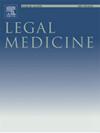利用死后计算机断层扫描和尸检结果有效诊断颈椎骨折。
IF 1.4
4区 医学
Q3 MEDICINE, LEGAL
引用次数: 0
摘要
一个常见的法医问题是颈椎骨折,有时只需要通过身体检查来诊断,而不需要成像或尸检。尽管来自临床实践的报告描述了颈椎骨折和头部损伤之间的联系,但我们无法找到任何尸检病例的分析。此外,通过死后计算机断层扫描(PMCT)诊断颈椎骨折的讨论似乎有限。本研究旨在检验尸检和PMCT的结果,并探讨有效的诊断方法。我们分析了在我科引入PMCT之前(2004-2010)和之后(2014-2020)7年间颈椎骨折的尸检病例。2014-2020年共记录了67例颈椎骨折尸检病例,其中61例(91%)与头部钝性损伤有关。颈椎骨折的患者发生头部钝性损伤的几率明显更高(50%)。颈部外力中,“伸”力占82.1%。所有尸检病例的颈椎骨折阳性率从2004-2010年的11例(4.0%)显著上升至2014-2020年的67例(8.2%)(p = 0.021)。2015年12月至2020年12月,在PMCT中积极进行“颈椎后屈”显像时,颈椎骨折诊断率从颈椎正常位的57.1%显著增加到“颈椎后屈”位的81.0% (p = 0.021)。钝性头部损伤和“颈椎后屈”位的PMCT可能对颈椎骨折的诊断有用。本文章由计算机程序翻译,如有差异,请以英文原文为准。
Effective diagnosis of cervical fracture using postmortem computed tomography and autopsy findings
A common forensic problem is cervical fractures, which sometimes need to be diagnosed only by physical examination of the body, without imaging or autopsy. Despite reports from clinical practice describing the association between cervical fractures and head injury, we could not find any analysis of autopsy cases. In addition, discussion of the cervical fracture diagnosis by postmortem computed tomography (PMCT) appears limited. This study aimed to examine autopsy and PMCT findings and explore valid methods for the diagnosis. We analyzed autopsy cases of cervical fractures during the 7 years before (2004–2010) and after (2014–2020) the PMCT introduction in our department. In 2014–2020, 67 autopsy cases with cervical fractures were recorded, of which 61 (91 %) were related to blunt injury to the head. Those with cervical fractures had a significantly higher incidence of blunt injury to the head (p < 0.001), particularly “forehead” and “face” injury, which accounted for > 50 % of cases. Of the external forces on the neck, “extension” accounted for 82.1 %. The cervical fracture-positive rate in all autopsy cases increased significantly from 11 (4.0 %) in 2004–2010 to 67 (8.2 %) in 2014–2020 (p = 0.021). From December 2015 to December 2020, when “cervical retroflexion” imaging was actively performed in PMCT, the cervical fracture diagnosis rate increased significantly from 57.1 % in the cervical normal position to 81.0 % with the addition of “cervical retroflexion” position (p = 0.021). Blunt head injury and PMCT in the “cervical retroflexion” position may be useful in the diagnosis of cervical fractures.
求助全文
通过发布文献求助,成功后即可免费获取论文全文。
去求助
来源期刊

Legal Medicine
Nursing-Issues, Ethics and Legal Aspects
CiteScore
2.80
自引率
6.70%
发文量
119
审稿时长
7.9 weeks
期刊介绍:
Legal Medicine provides an international forum for the publication of original articles, reviews and correspondence on subjects that cover practical and theoretical areas of interest relating to the wide range of legal medicine.
Subjects covered include forensic pathology, toxicology, odontology, anthropology, criminalistics, immunochemistry, hemogenetics and forensic aspects of biological science with emphasis on DNA analysis and molecular biology. Submissions dealing with medicolegal problems such as malpractice, insurance, child abuse or ethics in medical practice are also acceptable.
 求助内容:
求助内容: 应助结果提醒方式:
应助结果提醒方式:


